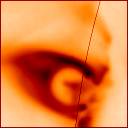Cusps Within Cusps
Cusps Within Cusps
Science Nugget: September 14, 2001
Introduction
We love cusps. There
have been several Nuggets dedicated to them (see here )
and several tens mentioning them. We have had Magnificent
cusps and Cusps
upon Cusps . The Sun continues to surprise us by its ingenuity,
and this Nugget will discuss cusps within cusps, prompted by a very
nice example seen this week.
A Reminder

Here is the standard 'magnificent cusp' image. What do these
pointy loops mean to us? We believe that in the solar corona, the
shapes of the emitting plasma that we see are almost totally
controlled by the magnetic field, so the pointed shape of a cusp
indicates that magnetic field lines are converging, while the fact
that a cusp is so bright implies heating is taking place, or has taken
place somewhere nearby. Both of these are consistent with magnetic
reconnection taking place or having taken place. As regular readers
will know, reconnection which is the mechanism of choice for solar
flares. For examples of 'Standard' flare cartoons involving cusps see
here
or here
or here
, to name but a few.
Nested Cusps
Our attention was caught by this small but very distinct cusp which
appeared in data on September 13th (RHS), apparently arising from the
interaction of two sets of loops side-by-side (LHS).

As well as its lovely shape, it was noticeable because within the main
outer cusp there seems to be a smaller inner cusp. This is a feature
which was also seen in one of the greatest cusps of all time

So How Does it Happen?
Remembering that the cusp implies magnetic reconnection, how can two
cusps appear together? In the `standard model', field lines below the
cusp are rounded, already reconnected field lines, so one cusp cannot
be directly below the other as the geometry of the field would not
permit this. So perhaps we see two cusps in different different
vertical planes, but formed at two very different heights by two
separate but related reconnection events. An upper and a lower
reconnection region is a feature of magnetic breakout models,
e.g.
here,
though the models as they stand also have problems
explaining the configuration we see.
On the other hand, a twisted loop viewed at an angle can also look
like a cusp, as an experiment with a piece of wire, or the four
figures below will easily show. So maybe all we are seeing is a small
twisted loop orientated at an angle to the plane of the main cusp. But
this forces us to think in three dimensions about the flare, which
many models can not yet do. And we also have to explain the hot loop
low down and at an angle... could it be related to the presence of a
flux rope which many people think is what makes the active region go
unstable in the first place?



 A loop which is semicircular in the back plane but with a small
twist in the bottom plane will look like a cusp at certain viewing
angles.
A loop which is semicircular in the back plane but with a small
twist in the bottom plane will look like a cusp at certain viewing
angles.
As we write this nugget on Friday September 14th, thousands mourn
family and friends who were lost in the terrorist attacks on the World
Trade Center, the Pentagon, and UA Flight 93, and millions honour the
victims with a day of remembrance. From the fourth floor of
D-Toh, we also express our deepest sympathy.
September 14, 2001
L. Fletcher ( lyndsay@astro.gla.ac.uk );
H. Hudson ( hudson@isass1.solar.isas.ac.jp )







